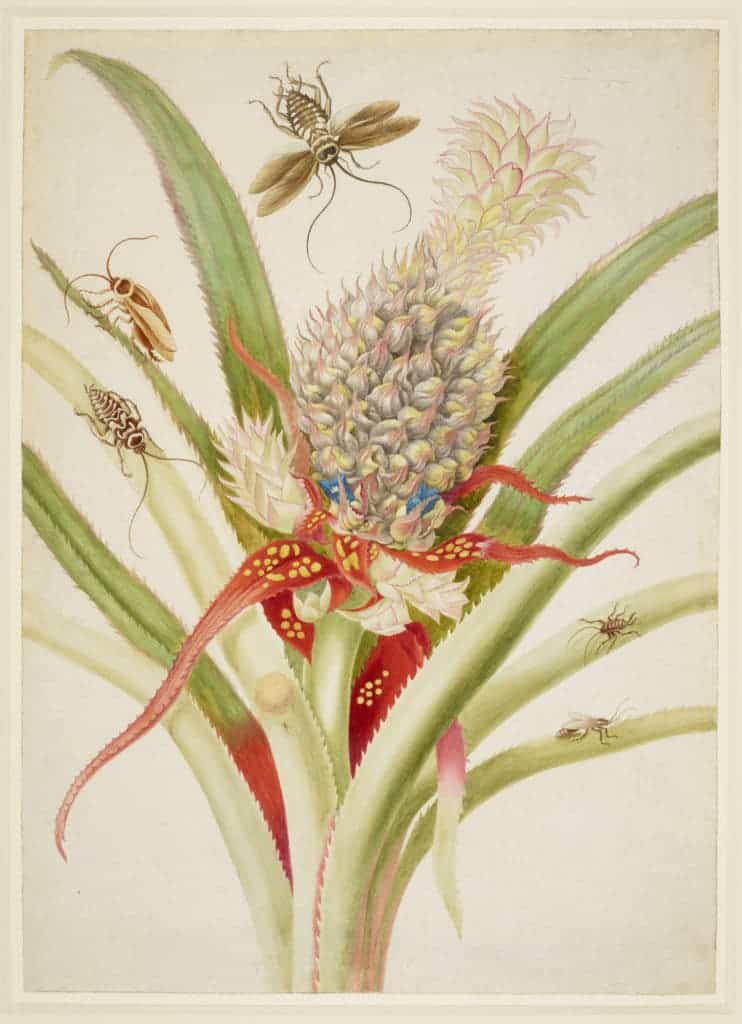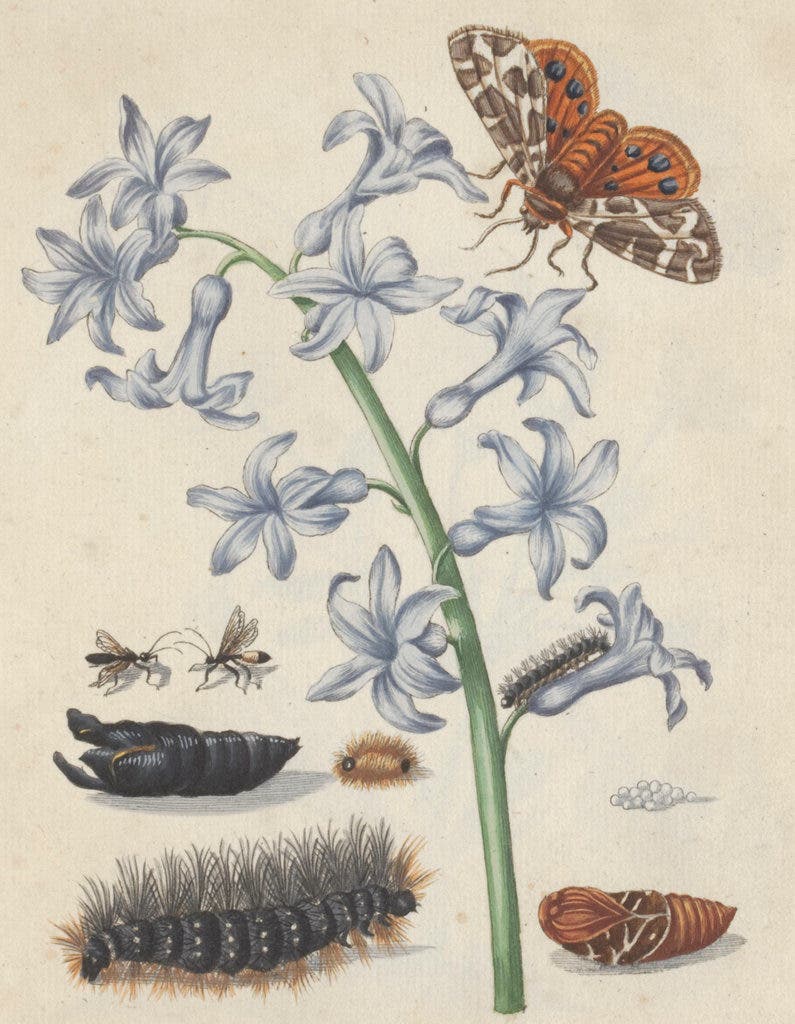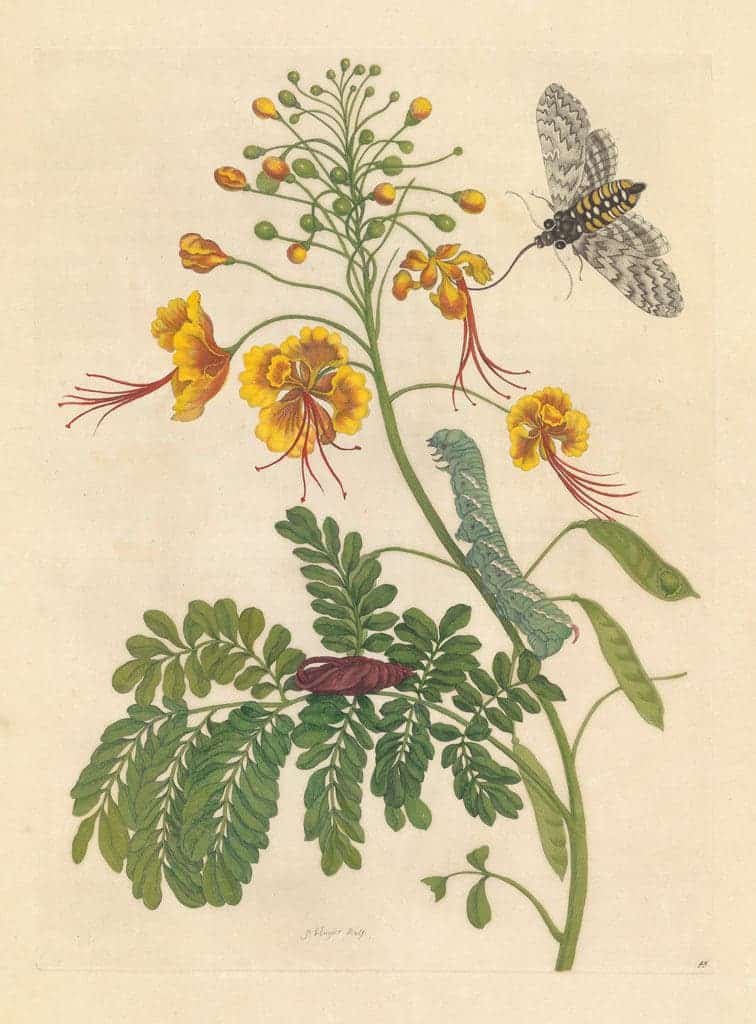Let’s just get this out of the way: women in science don’t get enough recognition. Sure, it’s better now than it was a century or two ago, but throughout human history, women have seldom received the academic credits they deserved — face it, most people would be hard-pressed to name a female scientist, perhaps with the notable exception of Marie Curie. Yet history teems with remarkable women who challenged the unfair status quo and went on to accomplish great things. Here, we celebrate such a woman: Maria Sibylla Merian, who 300 years ago had a highly successful career as an artist, botanist, and entomologist.

In the history of scientific art, few can claim to deliver works as striking as Maria Sibylla Merian. Born in 1647, her drawings created a sensation in the scientific circles, yet her name was belittled by shoddy reconstructions, a century after her time (more on that later). Almost apologetically, the Dictionary of Women Artists writes:
“The importance of Merian is based on a specific, perhaps feminine synthesis of an observant and at the same time contemplative view of nature.”
It’s almost as if she was too much of an artist to be considered a scientist, and too much of a scientist to be considered an artist. I’d argue that she was just enough of both.
A woman’s life?

Like most women during her day, Merian’s “day job” was taking care of the house and children — which makes her accomplishments even more impressive. But the German-born woman who settled in the Netherlands wasn’t satisfied with that. From a young age, she made valuable observations, helping dispel the myth that insects pop spontaneously from mud (yes, people believed that).
“She was a scientist on the level with a lot of people we spend a lot of time talking about,” said Kay Etheridge, a biologist at Gettysburg College in Pennsylvania who has been studying the scientific history of Merian’s work. “She didn’t do as much to change biology as Darwin, but she was significant.”
It didn’t take long for Merian to understand that things are much more difficult when you’re a woman. She was never allowed to train and practice oil painting, so she focused on drawing, watercolor, still-life painting, and copper-plate engraving in the family atelier. Raised in protestant Frankfurt, she grew up alongside her family’s successful publishing business. After her father passed away, her mother remarried — which in a way, also turned out fortuitous — still-life painter Jacob Marrell who taught Maria Sibylla alongside his sons. There were limitations, but at least she received a proper artistic education.
She published early, first focusing on the arts. Her first book, Neues Blumenbuch, was a floral pattern book for embroidery — a “feminine” art, in which she was also very capable. The men in her family traveled far and wide while Merian dutifully stayed at home — but she didn’t just waste her days idling. She learned as much as possible, taking advantage of the publisher’s workshop which served as an intellectual workshop. Her biographer Kim Todd explains in Chrysalis: Maria Sibylla Merian and the Secrets of Metamorphosis:
“The business depended on the dreaming up of fresh ideas, always a risky endeavour when the only reading material above suspicion was the Bible. Some had doubts about whether anyone but ministers should even read that. A refuge for scientists, religious minorities, and visionaries, a publisher’s workshop drew free thinkers of every stripe.”

Maria Sibylla Merian, a German-born woman living in the Netherlands, had a successful career as an artist, botanist, naturalist and entomologist. CreditJacob Houbraken, after Georg Gsell, via Metamorphosis insectorum Surinamensium, Amsterdam 1705, The Hague, National Library of the Netherlands
For a while, she maintained a conventional, orthodox way of painting — something suitable for a housewife of the time, though she was also a teacher. Yet her interests went far beyond painting fruits and landscapes: she had a habit of breeding insects, especially caterpillars, observing and painting their metamorphosis.
“Her focus on breeding, habitat and metamorphosis fits nicely with the domestic practice of a 17th-century mother and housewife,” observed the historian Natalie Zemon Davis, who cautions against reducing Merian’s preoccupation to an innate feminine response to nature.
Art and science
It’s very likely that that’s when she really started to hone her skills as a naturalist. She quickly learned how insects develop and what they need, and was careful not only to bring the insect in question along — but also a small part of its habitat. Her deep reverence for nature is visible in all her works, even though some paintings carry a raw, almost violent theme with them.

Although it was the rare passion in entomology that brought her some modest fame, her interest in science wasn’t limited to insects. She also spent some time focusing on the evolution of frogs, and to this day, is regarded as one of the greatest botanical artists. Her study of butterflies is also renowned and can currently be seen in the Royal Collection in England.
“She would sit up all night until they came out of the pupa so she could draw them,” Etheridge said.
She was somewhat well known within both scientific and artistic circles — especially by women. At one point, she ran what was, as far as we know, the only all-female scientific illustration workshop in Europe. At a time when science was almost exclusively a pursuit of rich (or rich-ish) white men, Merian made her income strictly from science and teaching. Even today, I’d say that’s a reason to be proud.
After a while, she divorced her husband and joined a protestant sect, the Labadists. Her husband did attempt to convince her to return, but the sect said that she didn’t have any obligations. It was a peculiar situation, as Merian too was an unusual woman. As it so often happens, one unusual thing leads to another — this time, it was spectacular.
Expedition to South America and a Magnum Opus
Merian moved to Amsterdam, where she reestablished herself. She took advantage of the Dutch laws which allowed women to run businesses and made quite a hefty sum by selling her illustrations. At the time, Amsterdam was the center of global tourism and explorers, and tradesmen often brought insects to her workshop. But for a scientist of her caliber, non-living samples can only do so much. What were their habitats and lifestyles? Impossible to tell. For someone who built the entire stage of an ecosystem, having only the (dead) lead actor didn’t do much. So devised a plan: a brave scientific explanation to South America.
While completing her daughters’ education, she raised money for the expedition. In 1699, at the age of 52, Merian sold her paintings and made her will. Alongside her youngest daughter, she took a ship for a Labadist colony in today’s Suriname. Through this, the protestant sect turned out to be pivotal for her success and legacy.

The trip alone lasted two months and was perilous. The colony wasn’t any safer. A fragile settlement, with supplies often at the mercy of pirates and tropical diseases running rampant, it was hardly a place for a woman in her 50s. But Merian persevered, and for two years, she and her daughter spent their days studying the local flora and fauna. The Dutch empire at the time was ruthless, running a massive slave market. Merian recalled that slaves helped her greatly:
“The forest grew together so closely with thistles and thorns, I sent slaves with hatchets ahead, so that they chopped an opening for me, in order to go through to some extent, which was nevertheless rather cumbersome.”
Other than this and her complaints of colonists focusing almost exclusively on growing sugar cane, her studies and notes completely ignored humans. It was only one one occasion that she noted on a depiction of a peacock flower, used by female slaves for abortions:
“The Indians, who are not treated well by their Dutch masters, use the seeds to abort their children, so that they will not become slaves like themselves. The black slaves from Guinea and Angola have demanded to be well treated, threatening to refuse to have children. In fact, they sometimes take their own lives because they are treated so badly, and because they believe they will be born again, free and living in their own land. They told me this themselves.”
After two years, her health greatly deteriorated, due to a disease (likely either malaria or yellow fever). She returned to Amsterdam, but still had enough energy to raise money to publish her work. It would become her magnum opus: “Metamorphosis Insectorum Surinamensium.”
Her work revealed a world so wild and exotic that it simply shocked naturalists at the time. It received widespread acclaim, conjuring habitats and ecosystems beyond what the world had seen at the time. Like Marien herself, it was an unusual blaze of color, art, and science intertwined in a hypnotic dance.
Legacy and inspiration

After all this, she quickly became a sensation, but her health was frail. After suffering a stroke and become partly paralyzed, Maria Sibylla Merian lived her last days in Amsterdam as a pauper. The interest she spurred lasted for a longer time, and many followed in her footsteps. Yet for the longest time, her importance was regarded as strictly artistic, not scientific.
A series of shoddy reconstructions of her work led many Victorian scientists (using that term loosely) to raise doubts about the importance of her studies. For instance, Merian noted that the split tongues of sphinx moths depicted in a painting combine to form one tube for drinking nectar. Some have criticized this statement, saying that there is only one tongue — but Merian was not wrong. For a brief period, right after it emerges from its pupa, the moth has two tongues. Her brutal depiction of a tarantula devouring a hummingbird was thought to be impossible, only to be once again proven right centuries later.
During Victorian times (18th and 19th century), there was also a wide movement which minimized the merits of women in science — and Merian was not spared. During her lifetime, people were fascinated by her work and cared less about her gender, but for the Victorians, things were different.
“It was kind of stunning when she sort of dropped off into oblivion,” said Dr. Etheridge. “Victorians started putting women in a box, and they’re still trying to crawl out of it.”
This isn’t to say that her work was flawless — after all, what is science without errors? For instance, she was right about the tarantula and about ants building bridges, but sometimes she lumped together army and leaf-cutter ants. She would also paint a caterpillar next to a different type of moth. Some of these mistakes can be attributed to her decaying health, or to the fact that she painted some works a year or two after returning from Suriname. It also wouldn’t be fair to say that she should take all the credit by herself. Her daughters helped her with the illustrations, and she got a lot of help from others when it came to planning the trip and identifying species. But she was truly an inspiration for women and men alike.
It’s unfair that her name was tarnished, but today, her reputation is fully restored — though few have ever heard her name. A pioneer in art and biology, she was truly ahead of its time. It’s striking that today, three centuries later, women still struggle with the same things she did.


